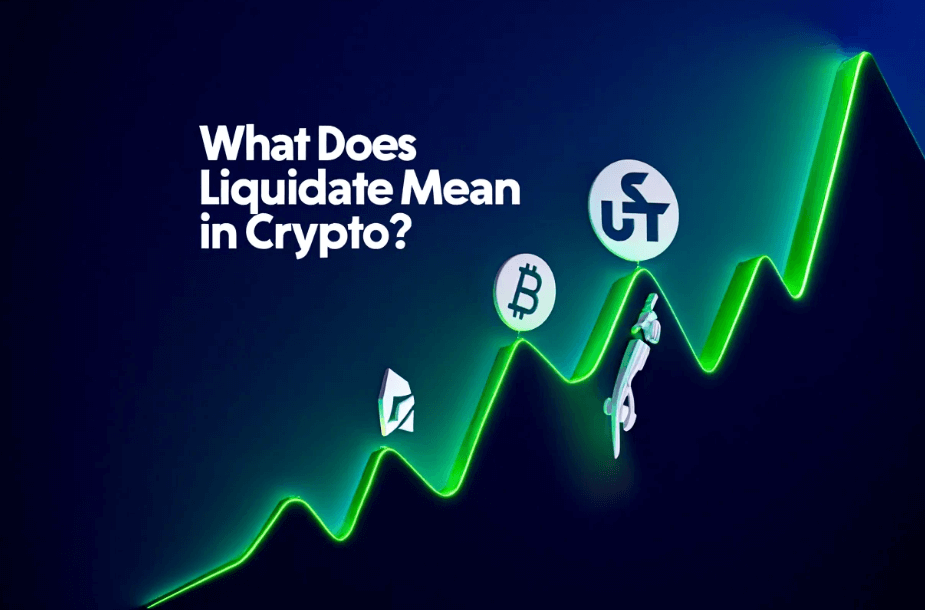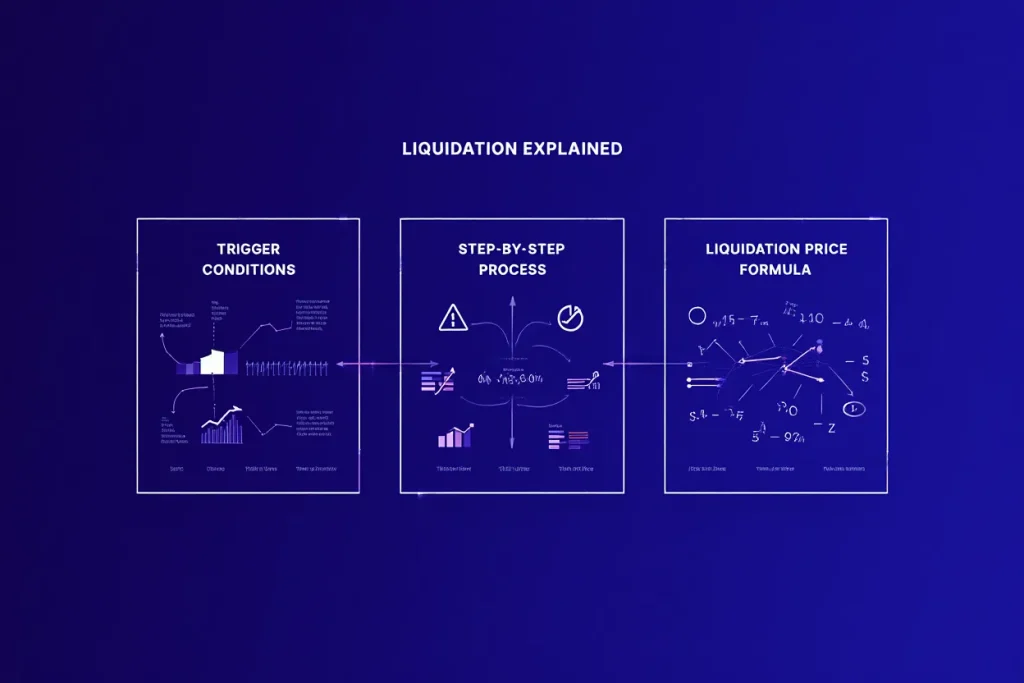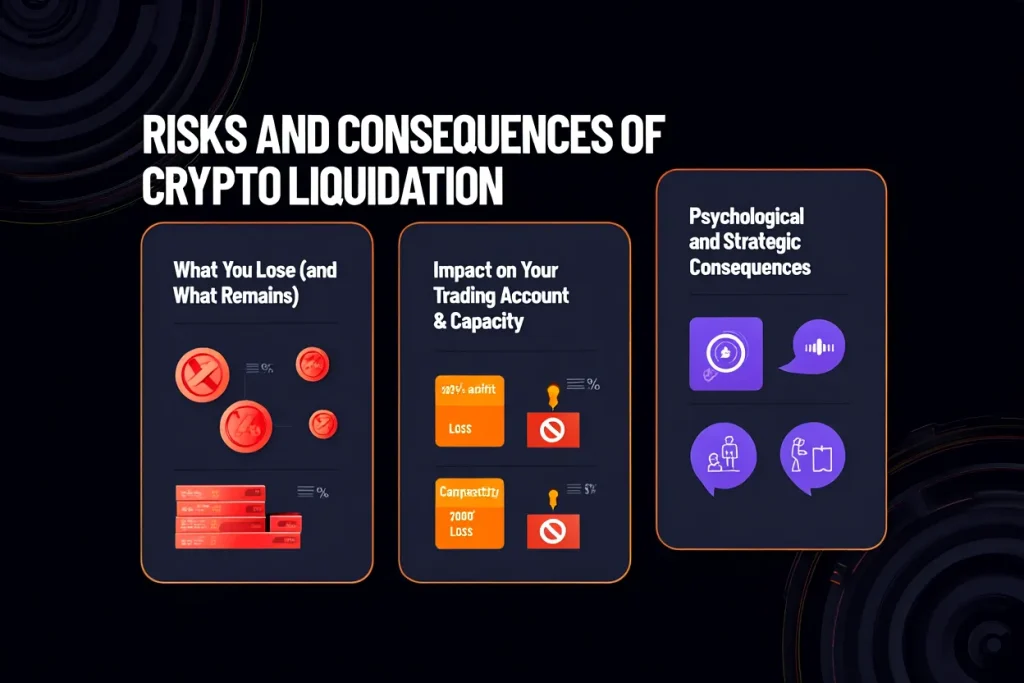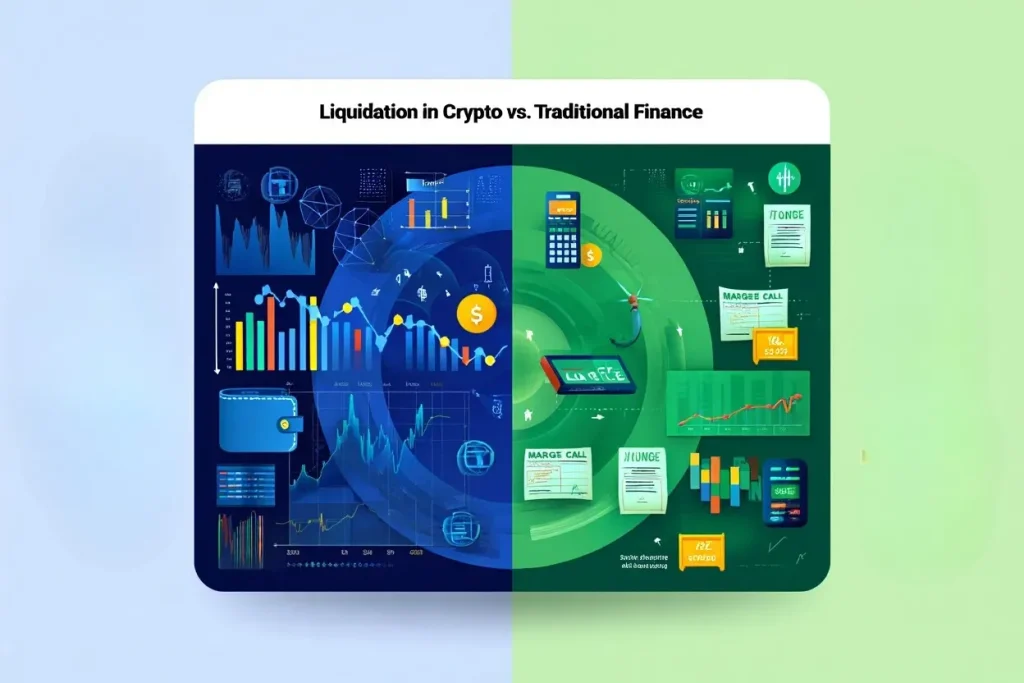Physical Address
304 North Cardinal St.
Dorchester Center, MA 02124
Physical Address
304 North Cardinal St.
Dorchester Center, MA 02124

In the world of cryptocurrency, “liquidation” isn’t just a buzzword it’s a pivotal concept that every investor and trader, from beginners to seasoned professionals, needs to grasp. In crypto trading, liquidation occurs when an exchange automatically closes your position to prevent losses from exceeding your collateral. With the fast pace and volatility the crypto markets have shown such as during the 2024 Bitcoin flash crash that triggered over $2 billion in liquidations in a single day understanding how and why liquidation happens is more crucial than ever.
This guide offers a deep dive into what liquidation means in crypto, uncovering the processes, warning signs, and consequences, plus actionable ways to avoid it. We’ll explore the full lifecycle of a liquidation event, compare crypto to traditional finance, provide practical risk management tips, answer frequently asked questions, and supply the essential glossary every trader should know.
Crypto liquidations operate much faster, and often more harshly, than those in stock or forex markets, making them unique and sometimes unforgiving. Ready to learn how to protect your assets and trade with confidence? With Webtaichinh, let’s get started by grounding ourselves in the fundamentals.
Definition: In crypto trading, liquidation refers to the automatic, forced closure of an open position by an exchange when your collateral (the funds you have as security) drops below a required threshold due to adverse price movements. Unlike choosing to sell at a certain price, liquidation is triggered by the exchange to prevent further loss and safeguard both your account and the platform.

Key distinction: Voluntary selling or closing a position is your choice, aiming for profit or loss mitigation. Liquidation is automatic and often sudden, driven by the exchange’s risk controls not your own market decisions. Understanding these terms is crucial as we dive into the mechanics of how liquidation happens.
There are two ways a position can be liquidated in crypto: “Voluntary” and “Forced.” Voluntary liquidation means you close your own position, whereas forced liquidation happens when the exchange intervenes most often in leveraged trading. Forced liquidations carry higher risk due to fast-moving crypto prices and are a key risk every margin trader faces.
| Type | Who initiates? | When it happens |
|---|---|---|
| Voluntary | Trader | Any time, by choice |
| Forced | Exchange/System | When margin requirement isn’t met |
Forced liquidation is especially critical in crypto due to high volatility and regular use of leverage, which means understanding the triggers is essential.

This process happens quickly sometimes in seconds during rapid price swings. The core link is between leverage (the multiplier on your funds) and your exposure: high leverage means less cushion for losses. As soon as your equity (collateral plus/minus unrealized P&L) falls below the maintenance margin, liquidation is triggered. During the infamous May 2024 Ethereum correction, many traders were auto-liquidated within minutes, reinforcing the need for vigilance around leverage and collateral levels.
On platforms like Binance, users see real-time UI messages tracking margin levels and get instant liquidation status updates, making the process transparent but sudden. This hands-on sequence helps demystify the abstract mechanics before you calculate your own risk.
The liquidation price is where your position will be forcibly closed. For a long position, a simple formula is:
Example: Buy ETH at $2,000 using 10x leverage.
Liquidation Price = $2,000 × (1 – 1/10) = $2,000 × 0.9 = $1,800
Variables: “Entry Price” is your initial buy/sell price. “Leverage” is the multiplier used. Knowing this lets you set smarter stops or adjust leverage for risk control.
Cryptocurrency markets are inherently volatile much more so than traditional stocks or forex. Dramatic 5-20% price swings in minutes can wipe out leveraged positions instantly. During the March 2024 mini-crash, over $1.2 billion in liquidations occurred in 12 hours a record since 2022. The chart below illustrates liquidation spikes during major volatility windows, showing how unpredictable price action dramatically increases liquidation risk for traders using high leverage.
Understanding this volatility is key to protecting your portfolio from unexpected forced closings.
Examples from 2024:
These incidents show the need for solid risk management, which we’ll cover next.

Consider a case where a trader allocates $2,000 as collateral on 10x leverage. If the position liquidates due to a sharp price movement, after covering losses, slippage, and fees, the trader might be left with only $100. The rest is used up to repay borrowed funds and cover platform fees, so you can lose almost all your initial deposit if not careful.
After liquidation, your available margin shrinks significantly, reducing or restricting your ability to open new trades. Many exchanges temporarily reduce borrowing limits or require a higher margin ratio after a forced liquidation to protect both the platform and the trader from repeated losses. These restrictions may stay in place until your account regains a healthy balance, impacting your trading strategy and flexibility.
Liquidation can shake your confidence, leading to frustration or the urge to quickly “win back” losses—a trap known as revenge trading. According to 2024 trader psychology surveys, most participants regretted impulsive post-liquidation trades, often deepening their losses. Recognizing these emotions is vital; sound risk management habits are as important as technical skills in the crypto market.
Implementing these habits won’t just reduce the risk of forced liquidation they’ll help you become a resilient, adaptive crypto trader. Utilizing stop-losses, tracking your margin closely, and avoiding over-leveraging ensure you can weather even turbulent market cycles. Combine these best practices with technology-driven alerts for a robust risk defense.
Related reads to deepen your knowledge:
| Tool/App | Main Feature | Best Use Case |
|---|---|---|
| Binance Margin Alerts | Real-time margin/liq notifications | Automatic warnings for positions |
| Bybit Risk Analyzer | Margin ratio tracking dashboard | Proactive risk assessment |
| CoinMarketCap Liquidation Data | Market-wide liquidation stats | Spotting market-wide risk spikes |
| 3Commas Portfolio Manager | Automated portfolio alerts | Multi-account tracking |
| CryptoQuant | Blockchain analytics & signals | On-chain risk monitoring |
| TradingView Alerts | Custom price/margin alerts | Personalized alert setup |
Using these tools helps you respond quickly to margin threats and keep your trading strategy on track, even in fast-moving crypto trends for 2025.

| Attribute | Crypto Liquidation | Stocks/Forex Margin Call |
|---|---|---|
| Speed | Instant, automated | Manual, can be delayed |
| Trigger | Margin ratio breach | Below maintenance margin |
| User Recourse | Little to none | Often can deposit more funds |
| Volatility | Extreme, frequent | Lower, less frequent |
Unlike stocks or forex, crypto liquidations are fast, tech-driven, and give less warning or recourse to traders. Understanding these differences will help you tune your strategy for the unique environment of digital assets.
Your collateral is used to cover trading losses, loan repayment, and any applicable fees. Any leftover balance is returned to your account, but in most cases, losses consume most of your original margin.
No, liquidations on crypto exchanges are typically final due to automated risk controls. Appeals are rarely successful, unless exchange error or technical issues are proven.
Liquidation can be partial or total, depending on the platform and your position size. Some exchanges liquidate only enough to restore your margin; others close your entire position in one go.
Exchanges sell your assets at the current market price to cover the debt. After fees and slippage, any remaining value is credited to your account. Specific handling methods are detailed in exchange T&Cs.
Fees vary by exchange but typically include a liquidation penalty (often 0.5–2% of position size) plus trading and funding fees. Always check your platform’s fee schedule to avoid surprises.
Usually no; most major exchanges enforce “isolated margin” so losses are capped at your collateral. However, in rare, extreme volatility (especially in cross margin mode or illiquid markets), negative balances can occur, though most platforms auto-repay or socialize losses.
Yes. Crypto liquidations are much more frequent than in stocks due to high leverage allowances and extreme 24/7 volatility. Automated liquidation systems in crypto also act much faster, making risk management even more critical.
Yes. Countries like the US, UK, and most of the EU impose strict leverage caps and mandatory risk warnings on crypto derivatives platforms. Some (e.g., China, India) have banned or strongly restricted leverage trading to limit retail losses.
Understanding liquidation in crypto is essential to navigating the fast-paced, high-risk world of digital asset trading. Liquidation means losing control of your position due to collateral shortfall, often resulting in partial or total losses. By mastering the mechanics, identifying root causes, and employing robust risk management tools, you can significantly reduce your chances of being forcibly liquidated. Remember: the combination of strategic planning, technology, and emotional discipline is your strongest defense. Stay informed, keep learning, and treat every trade as part of a long-term journey toward financial growth and security.
At webtaichinh, our mission is to provide you with clear, unbiased insights into the world of cryptocurrency through the Cryptocurrency category, helping you navigate complex topics with confidence, without hype or hidden agendas.
Webtaichinh delivers real-time financial updates, ensuring you stay informed about market trends, policies, and global economic developments. As part of our commitment to excellence, we provide accurate information and in-depth analysis, empowering investors to make swift, confident decisions in a dynamic financial world.
For inquiries or personalized assistance, feel free to contact us:
📞 Phone: 055 937 9204
📧 Email: webtaichinh@gmail.com
💻 Website: https://webtaichinh.vn/
📍 Address: 13 Ho Tung Mau, An Binh, Di An, Binh Duong
At webtaichinh, your financial success is our mission.